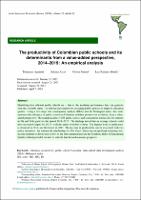| dc.creator | Agasisti, Tommaso |
| dc.creator | Arias, Juliana |
| dc.creator | Bernal, Gloria |
| dc.creator | Abadía, Luz Karime |
| dc.date.issued | 2024-04-07 |
| dc.identifier.issn | 2196-436X |
| dc.identifier.uri | http://hdl.handle.net/11651/5874 |
| dc.description | Efficiency, productivity, public school, Colombia, value-added, data envelopment análisis (DEA), Malmquist index |
| dc.description.abstract | Identifying how efficient public schools are – that is, the academic performance they can generate with the available inputs – is relevant information for designing public policies to improve education quality. Using a two-stage data envelopment analysis (DEA) and the Malmquist index, this study measures the efficiency of public schools in Colombia and their productivity evolution, from a valueadded perspective. The sample includes 3,854 public schools and standardized test records for students in 9th and 11th grade for the period 2014–2019. The findings reveal that on average schools could have increased outputs by 18.5% with the inputs available to them. The highest level of inefficiency is observed in 2014, and the lowest in 2017. The increase in productivity can be associated with two policy initiatives: the nationwide scholarship Ser Pilo Paga (which encouraged high-achieving low-income students to devote more effort to the exit examinations) and the Synthetic Index of Educational Quality (which provided rewards to schools that showed academic progress). |
| dc.format | application/PDF |
| dc.language.iso | eng |
| dc.publisher | Centro de Investigación y Docencia Económicas |
| dc.relation.ispartof | Latin American Economic Review, volumen 32, 2023 |
| dc.rights | La revista Latin American Economic Review autoriza a poner en acceso abierto de conformidad con las licencias CREATIVE COMMONS, aprobadas por el Consejo Académico Administrativo del CIDE, las cuales establecen los parámetros de difusión de las obras con fines no comerciales. Lo anterior sin perjuicio de los derechos morales que corresponden a los autores. |
| dc.source | 2196-436X |
| dc.title | The productivity of Colombian public schools and its determinants from a value-added perspective, 2014–2019: an empirical analysis |
| dc.type | Artículo |
| dc.accessrights | Acceso abierto |
| dc.recordIdentifier | 000005874 |
| dc.rights.license | Creative Commons Reconocimiento-NoComercial-SinObraDerivada 4.0 Internacional CC BY-NC-ND |
| dc.identifier.citation | En: Latin American Economic Review, volumen 32, 2023 |
| dc.identifier.doi | https://doi.org/10.60758/laer.v32.214 |
| dc.identifier.url | https://www.latinaer.org/index.php/laer/article/view/214 |


